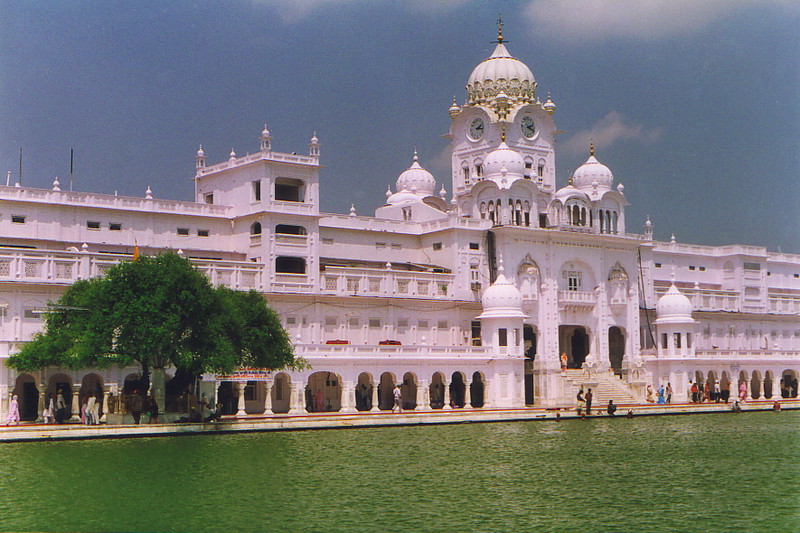
As pupils in school history classes we barely touched upon colonialism, an amazing omission given the importance of the British Empire in the continuing arrogance of the English abroad; if we did study it, it was only to mention British successes (such as the Battle of Plassey, the explorations of Captain Cook and the glory of Hong Kong) or to paint a vivid picture of the hardships forced upon us by the conquest of the developing world (such as the Black Hole of Calcutta, the Zulu wars and the exploration of North America).
But the British abroad were hardly angels; one only has to read Orwell's Burmese Days to see a different side to the glory of Mother England and her supposedly benign influence on her subject countries. I am constantly surprised by how biased my education was; I expect such a thing to happen in countries with oppressive and dictatorial regimes, but in Britain, the Land of Hope and Glory, the inventor of parliamentary democracy, the epitome of fairness and high morals? I've begun to explore the other side of the coin, and it's an ugly story. It seems I was fed propaganda at school.
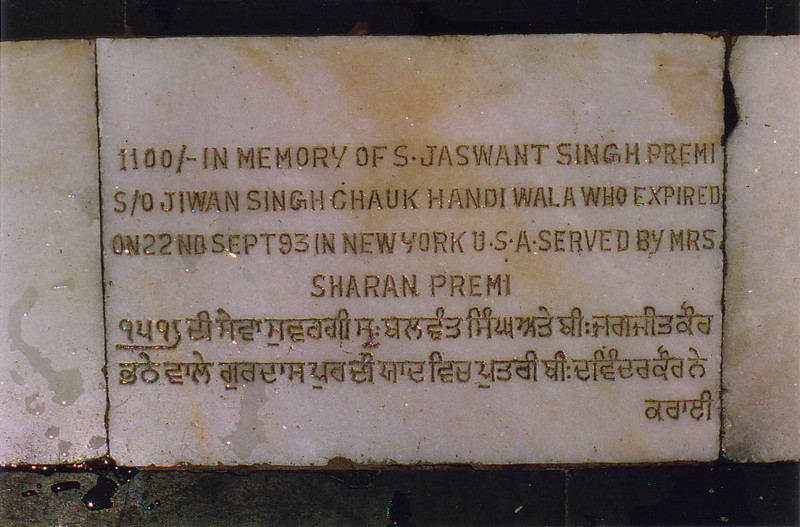
It happens everywhere: CNN isn't neutral and unbiased, and nor is the BBC, but we like to think that they are (most people will get very heated if you question the 'correctness' of their news programmes). Nothing is neutral; I know this because I am a journalist, and as a journalist I know it's practically impossible to write something that's completely objective. But my religious education was a Christian education, and we never learned about any other religions, a major oversight that has thankfully been rectified in the modern curriculum; my history lessons were conveniently selective, even though history is supposed to teach us to learn from our mistakes; geography lessons were selective too, avoiding concepts of famine and ecology in favour of motorway names, county boundaries and the main products of Canadian territories. I know you can't teach everything, but you can at least try to teach a balanced syllabus.
So I have been discovering another side to life through my interest in colonialism. At school I never learned anything about Malaysia or British Borneo, but their histories are fascinating, and are a good example of petty squabbling between advanced nations, irrespective of the effect on the people originally living there. Travelling through Australia and New Zealand opened up the worlds of the Aborigine and Maori to me, and Polynesia is a perfect example of colonial control that is both vindictive (nuclear testing) and beneficial (France pumping money into the country). I had to find out about this myself, and although it's been fascinating for me, it makes my education look worryingly incomplete.
Amritsar, the spiritual capital of the Punjab, is a perfect example. The Punjab is the home of the Sikhs, the easily recognised Indians who wear turbans, grow their hair and beards long, and who have set up very successful communities in places like Birmingham and the USA. The Punjab is now a peaceful state, but this is a recent development; until the early 1990s it was dangerous to travel here, and the region's history is a long story of armed struggle and bloodshed.
The Development of Sikhism
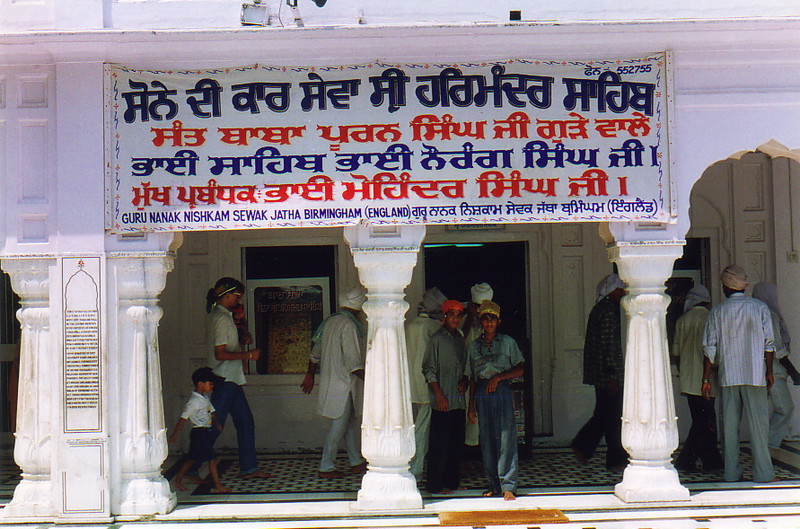
Sikhism was founded by Guru Nanak (1469-1539) who was, reading between the lines, a genuine hippy. He looked at Islam and Hinduism, and although he liked certain aspects of both religions, he was a serious liberal and wholeheartedly rejected the caste system of Hinduism and the intolerance and sexism of Islam. The result was his creation of a new religion, Sikhism, which blended the good parts of Hinduism and Sufism (Islam's mystical branch) into a religion of tolerance and universal appeal. Nine more gurus followed Nanak, each building on the faith and forming a loose nation of Sikhs in the Punjab area, the spiritual centre of which was the Golden Temple in Amritsar.
This all happened during the Mughal reign, and under the progressive Emperor Akbar and his successors, Sikhism flourished. But the last Mughal emperor, Aurangzeb, was a fanatical Muslim and spent most of his time tearing down Hindu temples and building mosques – thus alienating his subjects and paving the way for the end of Muslim rule in India – and Sikhism was suddenly under fire from the ruling class. This coincided with the leadership of Guru Gobind Singh (1666-1708) who turned Sikhism around, creating a militaristic and highly organised sect that vigorously defended its right to exist and which elevated the concept of martyrdom to new heights. The result was a whole population of men who were honourable, valiant and seriously tough, characteristics that, one can argue, are still predominant in modern Sikh society.
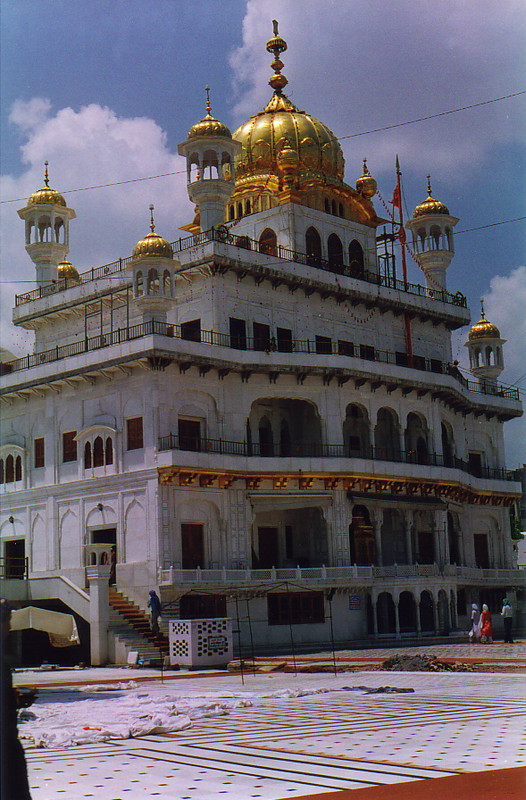
With the demise of the Mughals and the advent of the comparatively tolerant British rule, the Sikhs expanded their empire. The Golden Temple, which had a chequered history of being repeatedly captured by Muslims and being subsequently recaptured by Sikhs, stayed in Sikh hands from 1767 onwards. By 1839, under Ranjit Singh, the Sikhs ruled the Punjab, Kashmir, Ladakh, Balistan, Gilgit, Hazara and the Peshawar Valley (in other words what is now northeastern India and northern Pakistan) and had pushed the Afghans right back to the Khyber Pass. Ranjit had agreed in 1809 not to intrude on British territory, in return for being left alone by the Brits, but his successors flaunted this agreement, and in 1846 and 1849 the British fought two bloody wars with the Sikhs, eventually winning, and the Sikh empire was incorporated into British India. The Sikh culture, though, was allowed to continue unharmed, and Sikhs were included in the British army, much like the Nepalese Gurkhas.
This bloody history is an important part of Sikhism, if only because it is the reason for their distinctive appearance. Being on the move all the time, the Sikhs were unable to waste time on beautification, a stylistic nicety which has stuck: the knife, or kirpan – which is always carried and is exempted all over India in signs proclaiming, 'No weapons allowed, except for Sikh kirpans' – is an obvious symbol of armed struggle; and the traditional short trousers are worn instead of lungis because lungis are pretty useless if you need to run quickly over rough terrain. But surely the most impressive consequence of the Sikhs' armed past is the long history of martyrs, all of whom are revered like latter-day saints.
The Golden Temple, being the central Sikh shrine, has a whole gallery devoted to Sikh history and its martyrs. Occupying five rooms above the northern entrance to the temple, the museum consists of paintings of the key events in the history of Sikhism, and although it starts off with some pretty mellow historical scenes, it soon gives way to the violence and bloodshed that marks this particular struggle for religious freedom.
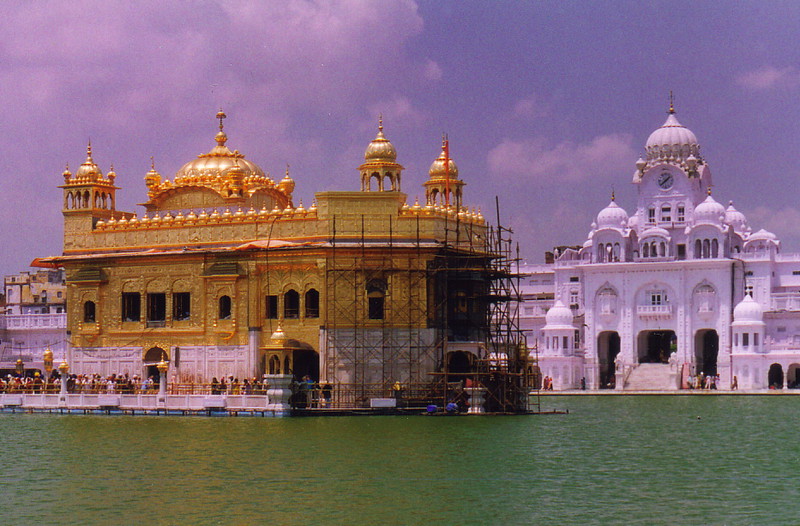
The first sign that something is up is a painting of a man being boiled alive, closely followed by another man being sawn in half from his head down. In each case it depicts a devotee being killed in the presence of his guru, but to me it wasn't initially clear if these pictures were showing religious persecution or an extreme test of bravery; what follows, however, puts one in no doubt that these are depictions of some of the more unpleasant ways in which Sikhs were killed by those of different religious persuasions (mainly Muslims) in a brutal attempt to convert them from their faith. There are pictures of Muslims butchering hundreds of Sikh babies, chopping off brave Sikh warriors' heads and, following on from these religious atrocities, a depiction of the 1919 massacre of an unarmed Sikh crowd by the British.
Of course, given its location in the holiest of all Sikh shrines, the museum can't avoid falling into the same trap as my own education. The theme throughout is the persecution of Sikhs, and although this is a well-documented part of the story of Sikhism, there are other areas of Sikh history that are perhaps more controversial. The modern era has spawned the Sikh extremist, some of whom are willing to go to terrible lengths to fight their cause. It's a truism that one man's terrorist is another man's freedom fighter, but it is, after all, only a few years since there was peace in the Punjab, and today you still see photograph displays of Sikh extremists in bus and train stations, each of them holding a prisoner number in front of them and wearing a defiant expression. For some people, wars are never over.
But it's hard to imagine the Punjab as a war zone. The change of scenery from Rajasthan to the Punjab is stunning; from desolate arid desert, you pass into a green and fertile land filled with fields of rice and wheat and criss-crossed by bulging rivers. The man next to me on the bus pointed out of the window and said, 'Is like England, yes?', and although I can't recall many paddy fields or palm trees in sunny Staffordshire, I can see what he meant. It is pure green; the Punjab produces 22 per cent of India's wheat and ten per cent of its rice, and it is home to the world's biggest bicycle manufacturer, Hero Bicycles. The Sikhs are master mechanics, and are renowned for their tolerance of other cultures and religions and their friendliness. This is not the product of terrorism, surely?
The Golden Temple
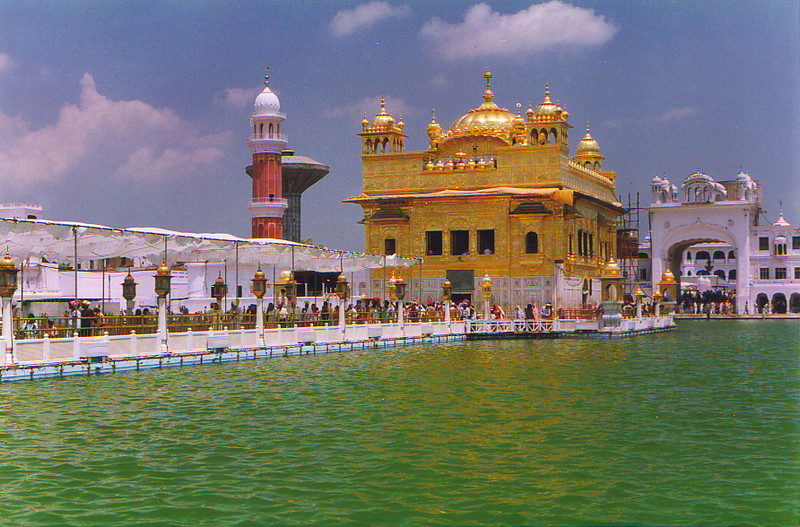
It's even harder to think of negative aspects of Sikhism when you visit the Golden Temple itself. A celebration of architecture, aesthetics, equality and piety, the Golden Temple is not only one of the most delightful temple complexes in India, with its large tank and glittering gold and white marble buildings, but it's also one of the friendliest. In most Hindu and Muslim temples there's a slight feeling of intrusion; as a non-Hindu you can't go into a Hindu temple's inner sanctum, and you might not be allowed into a mosque at all, especially if you're female, but Sikhism makes a point of its tolerance. Anyone and everyone can visit the Golden Temple regardless of colour, caste or creed, and the four entrances surrounding the complex symbolise this freedom. It lends a relaxed atmosphere to the interior; you can go anywhere, see anything and the only 'price' to pay is to take off your shoes and cover your head. Would that all religions were so tolerant.
The temple itself is a stunning piece of architecture, an ancient structure rebuilt so many times after destruction and war that it combines the old and the new in a successful union. A huge square tank, filled to the brim with dark water and huge carp, is surrounded by buildings, all done out in white marble and gleaming in the sunshine. The walkway surrounding the tank is wide and, even in the direct sunlight, cool; and dotted throughout the complex are marble plaques and carved memorials to Sikhs who died in wars, Sikhs who want to be commemorated in their holiest shrine, and other plaques containing details of large donations. Every space has its value printed on it, from Rs500 to Rs50,000, and each one has a story to tell, from lists of dead soldiers to New York Sikhs announcing their departure for their heavenly abode.
In the middle of the tank is the Golden Temple itself, the Hari Mandir (literally 'the Temple of God'). A long marble walkway leads to this square block of a building, whose lower walls are covered in inlaid flowers in patterns reminiscent of the Taj Mahal. The roof of the building, a melee of bulbous spires and domes, is totally smothered in gold, and manages to offset the marble quite beautifully in the architectural equivalent of milk and honey. It seems almost contradictory, but these garish whites and golds manage to give off a decidedly peaceful atmosphere; sitting round the edge of the lake watching the world go by is one of life's more relaxing experiences, especially as you don't tend to get interrupted quite as much as you do outside the temple (other visitors will of course talk to you, but they are polite in the extreme).
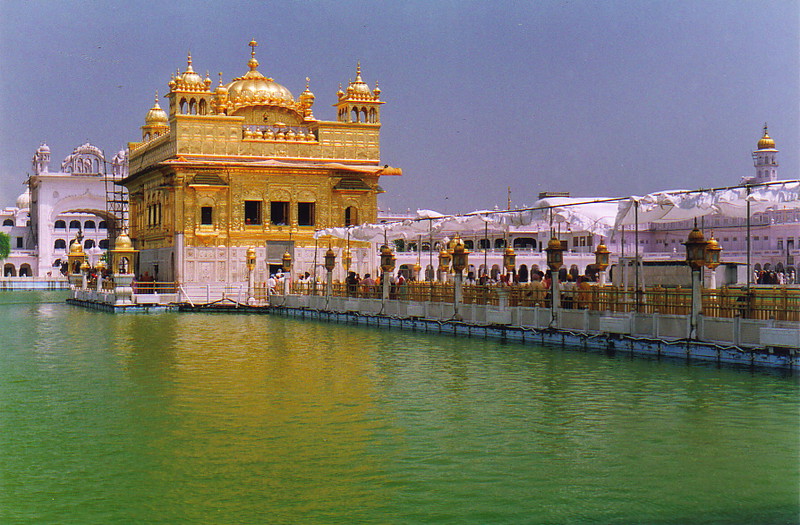
Throughout the day loudspeakers sound out the constant singing of the Sikhs' bible, the Adi Grantha, and where the equivalent in a Hindu temple would probably be insanely lively, the Adi Grantha chanting is a glorious synthesis of styles. I've listened to plenty of Indian classical music, but I've rarely come across music as evocative as that in the Golden Temple; I kept thinking of Harrison's 'Within You and Without You', itself a mixture of western Beatles music and classical eastern sitar. With its simple combination of keyboard, tabla and voice, I sat and listened for hours, marvelling at the complexity of a nation that can invent both wonderful classical music and infuriating pop.
The Golden Temple is a rich place, too. It's obvious when you look into the glass donation box, where people donate their spare change to contribute to the re-gilding of the temple's roof (most of which is being financed by donations from Birmingham's Sikh community). In one cursory glance I saw US$50, US$20, US$10, US$5 and US$1 notes, rupees from Pakistan, £20, £10 and £5 notes, German marks, gold rings, bracelets, earrings and a whole pile of large denomination Indian rupee bills. The buildings are sparklingly clean, the restoration work goes on tirelessly, and the sense of community is tangible.
A lot of this is down to the Sikhs' no-nonsense attitude to communal living. Pilgrims get free accommodation in a number of buildings dotted around the temple, and the communal kitchen, the Guru Ka Langar, serves free food at intervals throughout the day. Sharing showers, sharing meals and sharing dormitories makes for quite a change from a life of single hotel rooms, your own table in a restaurant and en suite bathrooms, but with the Sikhs being so friendly, I never felt embarrassment or any intrusion into my personal space while I stayed in the temple.
But even in this egalitarian society, we westerners were in an enclosure with good fans, lockable lockers, our own washing line and a guard or two at the door at all hours. Nobody could look in, so we could prance around in our underwear if we wanted, so in one important sense we weren't really a part of the community, because we could get our seclusion whenever we wanted. But it still felt good; finding genuine peace outside is impossible for tourists, and as for sleeping outside on the concrete, even the hardiest westerner would have problems with that...